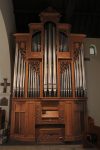Heaven Comes to Us
In June, 1917, a poem by an anonymous author appeared in the Hobo News of St. Louis, Missouri. Called “The Hobo’s Last Lament,” it relates the last words of one of those princes of the open road who was dying as he lay stretched out inside an empty boxcar on a railroad siding.
A fellow hobo is solemnly listening in. He hears his friend utter these words:
I’m going to a better land, where everything is bright,
Where beef-stews grow on bushes and you sleep out every night;
And you do not have to work at all, and never change your socks,
And streams of goodly whisky come trickling down the rocks.
The dying man has a message for his fellow wanderers. Don’t weep for him, he says. A train is coming: “A fast freight.” He intends to ride it to “a better land, where they hate the word called work”:
Hark, I hear her whistling, I must catch her on the fly;
I would like one scoop of beer once more before I die.
The hobo stopped, his head fell back, he’d sung his last refrain;
His old pal stole his coat and hat and caught an East-bound train.
So, what is heaven like?
Is it, as the fictional hobo imagined, a place of perfect indolence, of plentiful beef stew and open-air fountains of whisky and “a better land where they hate the word called work”?
Or does it conform more closely to the vision of John in the Book of Revelation? Later in chapter 21 — just beyond the passage that is today’s second lesson — John describes the very dimensions of the place with architectural precision: “The angel who talked to me had a measuring rod of gold to measure the city and its gates and walls. The city lies foursquare, its length the same as its width; and he measured the city with his rod, fifteen hundred miles; its length and width and height are equal. He also measured its wall, one hundred forty-four cubits by human measurement (about 216 feet), which the angel was using. The wall is built of jasper, while the city is pure gold, clear as glass. The foundations of the wall of the city are adorned with every jewel. … And the twelve gates are twelve pearls, each of the gates is a single pearl, and the street of the city is pure gold, transparent as glass” (21:15-19, 21).
This is where we get the idea of heaven having pearly gates and streets paved with gold. Yet, the vision of Revelation 21 is not about some distant heaven. The golden city with its gates of pearl does not exist in some far-off realm, on a higher spiritual plane. John’s triumphant vision is of heaven come to earth! The city comes “down out of heaven from God, prepared as a bride adorned for her husband” (v. 2).
By the grace of God, the day will finally come when we need not make a spectacular leap to celestial heights. On that great, glorious day, heaven will come to us.
Some folks think that heaven is completely separated from earth. It’s like Jesus’ grim parable of the poor man Lazarus and Dives, the contemptuous rich man who shunned him in life. The response of the blessed Lazarus to the rich man, tormented in a fiery place, is bleak: “Besides all this, between you and us a great chasm has been fixed, so that those who might want to pass from here to you cannot do so, and no one can cross from there to us” (Luke 16:26).
C.S. Lewis casts a different vision. In his novel The Last Battle, part of the Chronicles of Narnia series, Lewis allows his characters to glimpse heaven from a different perspective.
The victorious lion-king Aslan has triumphed over the forces of evil, but the land of Narnia has been destroyed. The Pevensie children join a host of virtuous humans and animals as they journey across a lovely landscape of grassy fields following Aslan, who has invited them to follow, but who is now so far ahead they can no longer see him.
They notice something wondrously strange about the place. It resembles the familiar landscape of Narnia, and yet it’s not Narnia.
“Those hills,” said Lucy, “the nice woody ones and the blue ones behind — aren’t they very like the Southern border of Narnia?”
“Like!” cried Edmund after a moment’s silence. “Why, they’re exactly alike. Look, there’s Mount Pire with his forked head, and there’s the pass into Archenland and everything!”
“And yet they’re not like,” said Lucy. “They’re different. They have more colors on them and they look farther away than I remembered and they’re more … more … oh, I don’t know …”
“More like the real thing,” said the Lord Digory softly.
It’s a vision of heaven come to earth — inspired, no doubt, by that vision of the golden, gem-studded city of Revelation 21. Yes, in the narrative of the novel, the vision of heaven is still distant and far-removed, but by its resemblance to the more familiar Narnia places, it is a vision of the heavenly city already descended.
Lewis explains what the children are seeing, through the words of Lord Digory: “Listen, Peter. When Aslan said you could never go back to Narnia, he meant the Narnia you were thinking of. But that was not the real Narnia. That had a beginning and an end. It was only a shadow or a copy of the real Narnia which has always been here and always will be here: just as our own world, England and all, is only a shadow or copy of something in Aslan’s real world. You need not mourn over Narnia, Lucy. All of the old Narnia that mattered, all the dear creatures, have been drawn into the real Narnia through the Door. And of course it is different: as different as a real thing is from a shadow or as waking life is from a dream.”
C.S. Lewis’ advice to us, communicated through the characters of this beloved tale, is to look for signs of heaven come to earth. They are all around us for the discerning spiritual eye to discover. We just may be lucky — or blessed — enough to glimpse them, imbedded in the daily routine of life, harbingers of greater glories yet to come.
“Christ Is Alive!,” an Easter hymn by Brian Wren, captures such wonder in this stanza: “Not throned above, remotely high, / untouched, unmoved by human pains, / but daily, in the midst of life, / our Savior with the Father reigns.”
If we are so blessed as to catch even a fleeting glimpse of such glory, our lives can never be the same again.
The hobo might hear the whistle of the Gloryland Express and dream of beef stew and whiskey, and we, too, may carry within our hearts a hope and longing for a world quite unlike the one we inhabit. I mean, who wouldn’t like walking on streets of gold?
Well, the good news is that the transformation of this earth has already begun, with the resurrection of Jesus. As the words of an Easter hymn written by Anglican priest and theologian John M.C. Crum puts it:
Now the green blade riseth from the buried grain,
Wheat that in dark earth many days has lain;
Love lives again, that with the dead has been:
Love is come again like wheat that springeth green.
Yes, God is making all things new. And heaven is coming to earth.
 St. Andrew’s Episcopal Church was established in Tampa in 1871. Its first service was held in the hospital building at Fort Brooke. A wooden church was erected in 1883 on the city block bounded by Marion, Twiggs, Morgan, and Madison.
St. Andrew’s Episcopal Church was established in Tampa in 1871. Its first service was held in the hospital building at Fort Brooke. A wooden church was erected in 1883 on the city block bounded by Marion, Twiggs, Morgan, and Madison. This history of the Windows of Saint Andrew’s is based upon research by the late Laban G. Lively. Additional information has been added by Nancy Turner. It is reconstructed for presentation on the WWW by Joe Daurril. Photos taken by Chris Cobb.
This history of the Windows of Saint Andrew’s is based upon research by the late Laban G. Lively. Additional information has been added by Nancy Turner. It is reconstructed for presentation on the WWW by Joe Daurril. Photos taken by Chris Cobb. The organ at St. Andrew’s Episcopal Church, Tampa, Florida, was designed and built by C. B. Fisk, Inc., of Gloucester, Massachusetts.
The organ at St. Andrew’s Episcopal Church, Tampa, Florida, was designed and built by C. B. Fisk, Inc., of Gloucester, Massachusetts. Ministry at St. Andrew’s is an integral part of our parish life and our community.
Ministry at St. Andrew’s is an integral part of our parish life and our community. St. Andrew's seeks to ensure that we are meeting the spiritual and religious education needs of all our members.
St. Andrew's seeks to ensure that we are meeting the spiritual and religious education needs of all our members.

 St. Andrew’s Episcopal Church was established in Tampa in 1871. Its first service was held in the hospital building at Fort Brooke. A wooden church was erected in 1883 on the city block bounded by Marion, Twiggs, Morgan, and Madison.
St. Andrew’s Episcopal Church was established in Tampa in 1871. Its first service was held in the hospital building at Fort Brooke. A wooden church was erected in 1883 on the city block bounded by Marion, Twiggs, Morgan, and Madison. This history of the Windows of Saint Andrew’s is based upon research by the late Laban G. Lively. Additional information has been added by Nancy Turner. It is reconstructed for presentation on the WWW by Joe Daurril. Photos taken by Chris Cobb.
This history of the Windows of Saint Andrew’s is based upon research by the late Laban G. Lively. Additional information has been added by Nancy Turner. It is reconstructed for presentation on the WWW by Joe Daurril. Photos taken by Chris Cobb.
 The organ at St. Andrew’s Episcopal Church, Tampa, Florida, was designed and built by C. B. Fisk, Inc., of Gloucester, Massachusetts.
The organ at St. Andrew’s Episcopal Church, Tampa, Florida, was designed and built by C. B. Fisk, Inc., of Gloucester, Massachusetts. Ministry at St. Andrew’s is an integral part of our parish life and our community.
Ministry at St. Andrew’s is an integral part of our parish life and our community. St. Andrew's seeks to ensure that we are meeting the spiritual and religious education needs of all our members.
St. Andrew's seeks to ensure that we are meeting the spiritual and religious education needs of all our members.